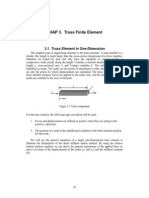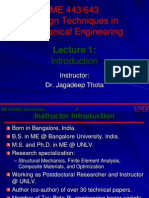Chapter 4
Uploaded by
swapnil kaleChapter 4
Uploaded by
swapnil kalei
TABLE OF CONTENTS
CHAPTER 4 - THEORY OF THE FINITE ELEMENT METHOD 4-1
4. INTRODUCTION 4-1
4.1 WHAT IS FINITE ELEMENT ANALYSIS? 4-1
4.2 HOW DOES THE FINITE ELEMENT METHOD WORK? 4-1
4.3 A BRIEF HISTORY OF THE METHOD 4-4
4.4 RANGE OF APPLICATIONS 4-5
4.5 COMMERCIAL FINITE ELEMENT SOFTWARE 4-6
4.6 FINITE ELEMENT ANALYSIS SOFTWARE ABAQUS
4-7
ii
LIST OF FIGURES
FIGURE 4-1 MAIN STEPS OF THE FINITE ELEMENT METHOD (ADAPTED FROM FAGAN, 1992)____________________4-3
FIGURE 4-2 THREE STAGES OF ABAQUS ANALYSIS (HIBITT ET AL, 2004) __________________________________4-7
iii
LIST OF TABLES
TABLE 4-1 TIME LINE OF IMPORTANT DEVELOPMENTS (HUEBNER, 2001) _________________________________4-5
TABLE 4-2 LEADING COMMERCIAL FINITE ELEMENT SOFTWARE COMPANIES (HUEBNER, 2001) _________________4-6
CHAPTER 4 THEORY OF THE FINITE ELEMENT METHOD 4-1
CHAPTER 4 - THEORY OF THE FINITE ELEMENT METHOD
4. INTRODUCTION
The following section gives insight into finite element method. It covers the history and
background of finite element analysis.
4.1 WHAT IS FINITE ELEMENT ANALYSIS?
The finite element method is a numerical analysis technique for obtaining approximate solutions
to a wide variety of engineering problems (Huebner, 2001). This method was designed to study
stresses in airframe structures and then adapted to a wider field of mechanics. Engineering
problems were solved by deriving differential equations relating to the problem. The principles
used for these differential equations were equilibrium, Newtons second law of motion,
conservation of mass, conservation of energy, and many more. Theses equations however, were
difficult to solve thus only very simple problems (for example rectangular, circular etc) could be
solved using these equations (Huebner, 2001).
Consequently the finite element method (FEM) of analysis was developed to assist in the solving
of these equations. Finite elements are used to solve a complex problem by dividing the problem
into smaller problems and solving them separately. Thus this method looks at a model as made
up of small inter-connected sub-regions of elements. The idea of the finite element method is that
a solution region i.e. a model can be analysed or approximated by replacing the region with a
finite number of distinct elements. These elements can then be place in different ways to make
up complex problems.
4.2 HOW DOES THE FINITE ELEMENT METHOD WORK?
In a problem which is any size the field variable i.e. the variable one is looking for, has an infinite
number of values because it is a function of each node or point within the model or solution
region. Thus the problem has an infinite number of unknowns.
There are three main steps in the finite element method, namely
Pre-Processing Phase
Analysis Phase
Post-Processing Phase
CHAPTER 4 THEORY OF THE FINITE ELEMENT METHOD 4-2
Each of the above steps is discussed in figure 4-1.
1) Discretization of the problem.
This procedure reduces the problem to a finite number of unknowns. This is done
by dividing the solution region into elements by taking into account any symmetry,
material changes, loadings or boundary conditions. The unknown field variable is
then expressed in terms of the assumed interpolation functions within each
element.
2) Selection of the interpolation functions.
The interpolation functions are defined in terms of the values of the field variables
at specified points called nodes or nodal points. Nodes reflect changes in material
properties, geometry, constraint conditions and applied loads. Nodes usually lie on
element boundaries where adjacent elements are connected. The interpolation
functions are chosen to represent the variation of the field variable over the
element. Polynomials are used as the interpolation functions for the field variable
because they are easier to integrate and differentiate. The degree of the polynomial
chosen depends on the number of nodes assigned to the element (i.e. one at each
corner or one in between each of the corner nodes as well), the number of
unknowns at each node and continuity requirements imposed at the nodes and
along the elemental boundaries. Simplex elements are when there are only corner
nodes and higher order elements are when there are nodes in between the corner
nodes.
Simplex elements.
Linear function.
Higher order elements.
Quadratic or cubic function.
3) Derivation of the basic element equations.
Once the model has been established the matrix equations expressing the
properties of the individual elements can be formulated. There are three different
methods namely, the direct method (for simple problems only), the variational
method, and the weighted residuals method.
The variational method is the more straight forward approach and involves
minimising the potential energy of the system. The weighted residuals method is
done by calculating the finite element equations directly from its governing
differential equation. It is done by substituting an approximate solution into the
differential equation and then working out the residual error.
The weighted residual method is more powerful than the variational formula
because almost any physical problem can be described by one or more differential
equations.
Variational formulation
method
Weighted residual method
P
R
E
P
R
O
C
E
S
S
I
N
G
P
H
A
S
E
CHAPTER 4 THEORY OF THE FINITE ELEMENT METHOD 4-3
FIGURE 4-1 MAIN STEPS OF THE FINITE ELEMENT METHOD (ADAPTED FROM FAGAN, 1992)
4) Incorporation of the boundary conditions.
Boundary conditions must be incorporated before the system equations are ready
for solution. Nodal values are imposed for the dependent variables or nodal loads.
5) Calculation of system equations.
The matrix equations for the individual elements are calculated.
The matrix equations for the individual elements are combined to form the matrix
equations for the entire system.
Simplex elements.
Exact evaluation.
Higher order elements.
Evaluation using numerical
integration.
6) Solving of the system equations.
The system equations are now solved to give the unknown values at the nodes. If
the problem is of an equilibrium nature, then the solution is obtained by solving a
set of linear or non-linear equations. Solving of these equations is done either by
the elimination method or the wavefront method.
Wavefront method Elimination method
A
N
A
L
Y
S
I
S
P
H
A
S
E
7) PostProcessing.
The displacements, strains or stresses etc. are calculated as required.
Simplex elements.
Evaluation at nodes.
Higher order elements.
Evaluation at integration points.
Extrapolation to nodes.
8) Presentation of results.
The nodal values are averaged.
The results may now be printed or plotted.
P
O
S
T
P
R
O
C
E
S
S
I
N
G
P
H
A
S
E
CHAPTER 4 THEORY OF THE FINITE ELEMENT METHOD 4-4
4.3 A BRIEF HISTORY OF THE METHOD
The finite element method dates back to the 1940s and has three different areas of origin. If one
asks who originated the finite element method the answer will depend on whether you ask an
applied mathematician, a physicist or an engineer. All of these specialists have some validation
for claiming the finite element method as their own as all three developed the essential ideas
independently at different times and for different reasons. The applied mathematicians were
concerned with continuum mechanics specially boundary value problems, and wanted to find
approximate upper and lower bounds for eigenvalues. The physicists were also involved in
continuum problems but were interested in finding piecewise approximation functions to
represent their continuous functions. The engineers were faced with increasingly complex
problems in aerospace structures, and were searching for a way to find the stiffness influence
coefficients of shell-type structures which are reinforced with ribs and bars. Thus the efforts of
these professionals resulted in three different sets of papers with three distinct viewpoints
(Huebner, 2001).
The main people involved in the founding and subsequent concepts of the finite element method
are: The work of Courant in 1943 was the first attempt to use piecewise continuous functions
defined over triangular domains which appear in applied mathematics literature (Huebner, 2001).
In 1959 Greenstadt came up with the idea to divide the solution region into smaller sub-regions
(Huebner, 2001). Hrenikoff (Huebner, 2001) reasoned that the difficulty of solving a more
complex truss structure can be overcome by assuming the continuum structure to be divided into
elements or sections that are interconnected by a finite number of node points. Using this
assumption the problem can be solved by the old methods. The actual solution of plane stress
problems by means of triangular elements whose properties were determined from the equations
of elasticity theory was first given in the 1956 paper of Turner, Clough, Martin and Topp (Brauer,
1988). They introduced the direct stiffness method for determining finite element properties. Their
studies, along with the arrival of the digital computer at that time, enabled the solving of complex
plane elasticity problems (Brauer, 1988).
Worldwide growth of the method has followed quickly since then and table 4-1 shows a timeline
of developments in computer hardware and software compared with developments in finite
elements.
CHAPTER 4 THEORY OF THE FINITE ELEMENT METHOD 4-5
TABLE 4-1 TIME LINE OF IMPORTANT DEVELOPMENTS (HUEBNER, 2001)
Computer Technology Year Analysis Technology
1941 Framework method
1943 Courant studies St. Venant torsion.
1944 Equivalent Circuits of Electric Field.
ENIAC 1 at University of Illinois. 1946
Transistor invented. 1947 Hypercircle Method.
IBMs first general purpose computer. 1953
FORTRAN created. 1954
Argyris publishes efficient solution
techniques.
1956 Classic paper solving plane stress.
1959 Greenstadts discretization approach
1960 Phrase finite element in coined.
First commercial integrated circuit. 1961
Mouse is patented. 1963
CDC introduces CDC6600 with 60-bit
words. BASIC created. First graphics
tablet.
1964
First commercial offering of finite element
software.
4.4 RANGE OF APPLICATIONS
Applications of the finite element method divide into three categories, depending on the nature of
the problem to be solved. The three categories are Steady state problems, Eigenvalue problems
and Transient problems.
Steady state problems are the most common problems used in finite element analysis. For an
elastic problem in equilibrium the problem can be solved and its distortion calculated. From the
displacements calculated the stresses and strains can be derived. For thermal analysis, the
temperature distribution and heat flow through a body can be calculated for a wide variety of
boundary conditions (Fagan, 1992).
Eigenvalue problems are an expansion of the equilibrium problems. They involve the calculation
of the fundamental characteristics of the system. These are steady state problems where the
determination of natural frequencies and modes of vibration of solids and fluids are required
(Fagan, 1992).
Transient problems are composed of the problems of the first two categories with a time
dimension added. The loads can be a function of time, and the finite element method is used to
calculate the forced response of a body. The propagation of stress waves and transient heat
flows form part of the transient problems (Fagan, 1992).
CHAPTER 4 THEORY OF THE FINITE ELEMENT METHOD 4-6
The range of possible applications of the finite element method extends to all engineering
disciplines; however civil, mechanical and aerospace engineers are the most frequent users of
the method.
4.5 COMMERCIAL FINITE ELEMENT SOFTWARE
The first commercial finite element software was available in 1964. The Control Data Corporation
sold it in time-sharing environment. No pre-processors were available at the time, so engineers
had to prepare the data element node by node, thus only linear problems could be addressed.
Later on, the finite element software could be purchased for corporate computers, until 1980
when the introduction of workstations brought several breakthrough advantages (Huebner,
2001).
Today there are many commercial software packages to choose from. A small number of these
packages dominate the market. It is difficult to make comparisons purely on a finite element
basis, because the software houses are often diversified. However, the dominant providers of
general purpose finite element software appear in table 4-2 (Huebner, 2001).
TABLE 4-2 LEADING COMMERCIAL FINITE ELEMENT SOFTWARE COMPANIES (HUEBNER, 2001)
Company Name Product Name Web site
Hibbitt, Karlsson & Sorensen ABAQUS
www.hks.com
Ansys, Incorporated ANSYS
www.ansys.com
Structural Data Research Corp. SDRC-Ideas
www.sdrc.com
Parametric Technology, Inc RASNA
www.ptc.com
MSC Software Corp. MSC/NASTRAN
www.mscsoftware.com
The software package that was used in this study was ABAQUS
mainly due to the fact that it is
readily available to the University and for its unique features.
ABAQUS
was founded in 1978 by David Hibbitt, Bengt Karlsson, and Paul Sorensen.
Abaqus has been written to maintain a general nonlinear approach to structural mechanics. This
means that the capabilities required to perform complex real-world simulations are the
foundation of the Abaqus technology. This advanced technology enables the modelling of the
most complex problems and the consideration of the slightest effects. Abaqus has a solution for
simple to complex linear and nonlinear engineering problems, using the finite element method. A
wide range of structural, thermal, and coupled analyses is supported.
CHAPTER 4 THEORY OF THE FINITE ELEMENT METHOD 4-7
For several years the ABAQUS
Research Edition License has enabled students in master and
doctoral level programs to analyse and solve realistic engineering problems at a reduced cost to
the universities. It is mainly for the reasons shown that the Abaqus program is used in this study.
4.6 FINITE ELEMENT ANALYSIS SOFTWARE ABAQUS
Abaqus is a collection of engineering simulation programs based on the finite element method.
This powerful program is able to solve relatively simple linear problems to the most challenging
nonlinear simulations. An extensive library of elements is included in Abaqus that can model
virtually any geometry. The behaviour of most common engineering materials can be simulate by
the material models, including metals, rubber, polymers, composites, reinforced concrete, foams,
soils and rock. Since Abaqus is designed as a general-purpose simulation tool, it can be used to
simulate problems in such diverse areas such as heat transfer, mass diffusion, thermal
management of electrical components, acoustics, soil mechanics and piezoelectric analysis
(Hibbitt et al, 2004).
A complete ABAQUS/Standard analysis generally consists of three stages namely, pre-
processing, simulation, post-processing. These stages are link together by files as shown in
figure 4-2.
FIGURE 4-2 THREE STAGES OF ABAQUS ANALYSIS (HIBITT ET AL, 2004)
Pre-processing
ABAQUS/CAE or other software
Input file:
J ob.inp
Simulation
ABAQUS/STANDARD or
ABAQUS/EXPLICIT
Output file:
J ob.odb job.dat
J ob.res job.fil
Post-processing
ABAQUS/CAE or other software
CHAPTER 4 THEORY OF THE FINITE ELEMENT METHOD 4-8
The pre-processing stage the problem is defined as a model and an Abaqus input file is created.
The model can be created in ABAQUS/CAE or any other pre-processor such as Solidworks, or
the input file can be directly created using a text program such as notepad.
The simulation is normally run as a background process where either ABAQUS/Standard or
ABAQUS/Explicit solves the problem numerically. These simulations make take seconds or days
to run depending on the complexity of the problem and the power of the computer used.
Once a simulation is completed the variables calculated i.e. the displacements, stresses etc. can
be viewed using the Visualization module of ABAQUS/CAE. This module can show the output file
in many ways including colour contour plots, animations, deformed shape plots, and X-Y plots
(Hibbitt et al, 2004).
An example of this process will be explained in detail in chapter 6 for a given simulation of this
study.
You might also like
- Finite element analysis is useful numerical technique to solve various structural problems. In this paper FEA model of slab column connection is model using ANSYS 16.0 . Punching shear failure is a major problem encountered in the design of reinforced concrete flat plates. The utilization of shear reinforcement via shear studs or other means has become a choice for improving the punching shear capacity .The obtained results indicate that, the proposed shear reinforcement system and drop panel has a positive effect in the enhancement of both the punching shear capacity and the strain energy of interior slab–column connection of both normal and high strength concrete. The general finite element software ANSYS can be used successfully to simulate the punching shearbehaviour of reinforced concrete flat plates.No ratings yetFinite element analysis is useful numerical technique to solve various structural problems. In this paper FEA model of slab column connection is model using ANSYS 16.0 . Punching shear failure is a major problem encountered in the design of reinforced concrete flat plates. The utilization of shear reinforcement via shear studs or other means has become a choice for improving the punching shear capacity .The obtained results indicate that, the proposed shear reinforcement system and drop panel has a positive effect in the enhancement of both the punching shear capacity and the strain energy of interior slab–column connection of both normal and high strength concrete. The general finite element software ANSYS can be used successfully to simulate the punching shearbehaviour of reinforced concrete flat plates.6 pages
- Mech Nonlin Connections 14.5 L02 Interface TreatmentsNo ratings yetMech Nonlin Connections 14.5 L02 Interface Treatments32 pages
- Introduction To ANSYS Introduction To ANSYS Mechanical: WKH 9 1 Workshop 9.1 Parameter Management GNo ratings yetIntroduction To ANSYS Introduction To ANSYS Mechanical: WKH 9 1 Workshop 9.1 Parameter Management G25 pages
- ANSYS Solutions For Drilling and Completion - SrinivasaNo ratings yetANSYS Solutions For Drilling and Completion - Srinivasa26 pages
- Introduction To ANSYS Mechanical: Workshop 6.2 Pre-Stressed Vibration AnalysisNo ratings yetIntroduction To ANSYS Mechanical: Workshop 6.2 Pre-Stressed Vibration Analysis11 pages
- ANSYS 10.0 Workbench Tutorial - Exercise 3, Named Selections and Localized LoadsNo ratings yetANSYS 10.0 Workbench Tutorial - Exercise 3, Named Selections and Localized Loads46 pages
- Reverse Engineering Gear Demo (PDFDrive)No ratings yetReverse Engineering Gear Demo (PDFDrive)120 pages
- Workshop 3.4 Named Selections + Object Generator: Introduction To ANSYS MechanicalNo ratings yetWorkshop 3.4 Named Selections + Object Generator: Introduction To ANSYS Mechanical15 pages
- Introduction To ANSYS Mechanical: Workshop 6.1 Free Vibration AnalysisNo ratings yetIntroduction To ANSYS Mechanical: Workshop 6.1 Free Vibration Analysis11 pages
- Introduction To ANSYS Mechanical: Workshop 8.1 Meshing EvaluationNo ratings yetIntroduction To ANSYS Mechanical: Workshop 8.1 Meshing Evaluation19 pages
- Introduction To ANSYS Mechanical: Workshop 7.1 Steady-State Thermal AnalysisNo ratings yetIntroduction To ANSYS Mechanical: Workshop 7.1 Steady-State Thermal Analysis14 pages
- Mesh-Intro 16.0 WS 07d Assembly Meshing PDFNo ratings yetMesh-Intro 16.0 WS 07d Assembly Meshing PDF26 pages
- FRANC3D V7 Training - Part 6 - Crack GrowthNo ratings yetFRANC3D V7 Training - Part 6 - Crack Growth19 pages
- Export Material Models To ANSYS Workbench 12No ratings yetExport Material Models To ANSYS Workbench 129 pages
- Multi-Scale Analyses On Seismic Damage and Progressive Failure ofNo ratings yetMulti-Scale Analyses On Seismic Damage and Progressive Failure of12 pages
- Introduction About Finite Element AnalysisNo ratings yetIntroduction About Finite Element Analysis19 pages
- Me8692 - Finite-element-Analysis - III Year-Vi SemesterNo ratings yetMe8692 - Finite-element-Analysis - III Year-Vi Semester189 pages
- Finite Element Analysis of Structural SystemsNo ratings yetFinite Element Analysis of Structural Systems255 pages
- Digimat: The Material Modeling PlatformNo ratings yetDigimat: The Material Modeling Platform24 pages
- Finite Element Analysis: MEEN 5330 Dustin Grant Kamlesh Borgaonkar Varsha Maddela Rupakkumar Patel Sandeep YarlagaddaNo ratings yetFinite Element Analysis: MEEN 5330 Dustin Grant Kamlesh Borgaonkar Varsha Maddela Rupakkumar Patel Sandeep Yarlagadda34 pages
- Finite Element Method ME751: Mechanical IV/IINo ratings yetFinite Element Method ME751: Mechanical IV/II23 pages
- FEM - Cont. & Chapt-1 - Slide PresentationNo ratings yetFEM - Cont. & Chapt-1 - Slide Presentation10 pages
- Unit-I Fundemental Concepts: State The Methods of Engineering AnalysisNo ratings yetUnit-I Fundemental Concepts: State The Methods of Engineering Analysis5 pages
- cbse-class-6-english-book-poorvi-a-rama-to-the-rescue-pdf-downloadNo ratings yetcbse-class-6-english-book-poorvi-a-rama-to-the-rescue-pdf-download19 pages
- MH STD 7 CH 11 Cell Structure and Micro-organismsNo ratings yetMH STD 7 CH 11 Cell Structure and Micro-organisms3 pages
- CBSE X CH1 Chemical Reations and Equations all solutionsNo ratings yetCBSE X CH1 Chemical Reations and Equations all solutions18 pages
- Physics Hints & Solution MHT-CET Triumph BookNo ratings yetPhysics Hints & Solution MHT-CET Triumph Book461 pages
- United States Patent (10) Patent No.: US 8,794,651 B2No ratings yetUnited States Patent (10) Patent No.: US 8,794,651 B229 pages
- Power-Assisted Bicycle: Official Handbook For Mandatory Theory TestNo ratings yetPower-Assisted Bicycle: Official Handbook For Mandatory Theory Test100 pages
- Computer Coding Projects For Kids - A Step-by-Step Visual Guide To Creating Your Own Scratch Projects PDF100% (2)Computer Coding Projects For Kids - A Step-by-Step Visual Guide To Creating Your Own Scratch Projects PDF226 pages
- Comparative Analysis of Parallel Vs Series Hybrid Electric PowertNo ratings yetComparative Analysis of Parallel Vs Series Hybrid Electric Powert52 pages
- Impact of Music and Cinema On The Students of Vit University - Project 2016No ratings yetImpact of Music and Cinema On The Students of Vit University - Project 201623 pages
- To Identify Specific Information in A TextNo ratings yetTo Identify Specific Information in A Text7 pages
- 12 Physics Notes Ch01 Electric Charges and FieldNo ratings yet12 Physics Notes Ch01 Electric Charges and Field3 pages
- AIP - Template - SDO Masbate School Template 2022 2023No ratings yetAIP - Template - SDO Masbate School Template 2022 20237 pages
- Senior Engineer (Technical Lead) - Engineering-RomaniaNo ratings yetSenior Engineer (Technical Lead) - Engineering-Romania2 pages
- Principles Involved in Handwriting Identification100% (3)Principles Involved in Handwriting Identification2 pages
- Class Schedule Sy 2021 2022 Senior High SchoolNo ratings yetClass Schedule Sy 2021 2022 Senior High School2 pages
- 14 - Fly Guy's Big Family _ Book Study ActivitiesNo ratings yet14 - Fly Guy's Big Family _ Book Study Activities62 pages
- General Questions For Interview: Q1: Tell Me About YourselfNo ratings yetGeneral Questions For Interview: Q1: Tell Me About Yourself5 pages
- Phutikettrkit,+3 +RFID+Hospitals+-+Edited+by+HBDSNo ratings yetPhutikettrkit,+3 +RFID+Hospitals+-+Edited+by+HBDS10 pages










































































































